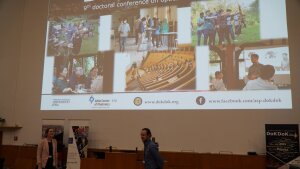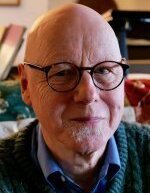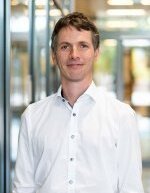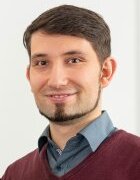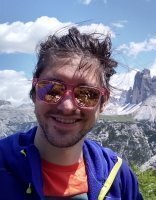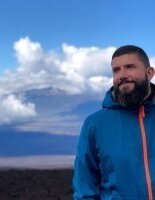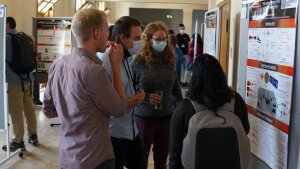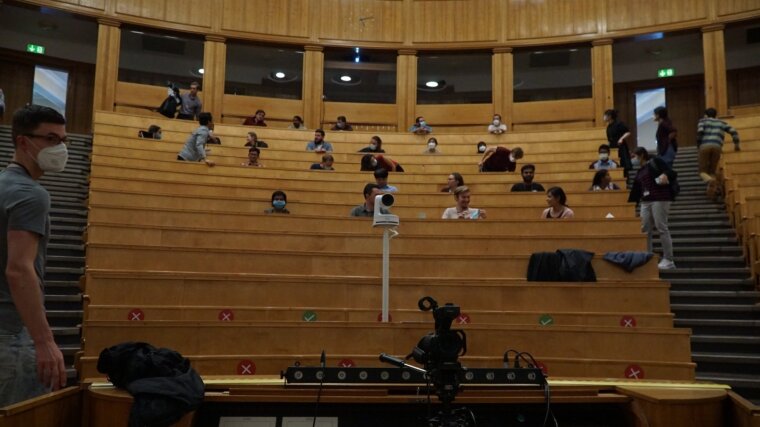
Opening of the DokDok 2021 in Jena.
Image: Malte SiemsDoKDoK was finally back!
Everything we like about DoKDoK – top-notch scientific exchange, unique insights by renowned keynotes, and a memorable social day – this year was held in Jena, the City of Light, from 1st – 3rd September in the auditorium HS 1 at Max-Wien-Platz.
Look herepdf, 30 kb · de for the program of the DoKDoK-lite 2021!
Keynote speakers
-
"Three decades riding the photonic crystal fibre wave"
Thirty years ago I proposed that a hair-thin glass fibre perforated along its length with an array of microscopic hollow channels might guide light in novel ways. In such a "photonic crystal fibre" (PCF) the hollow channels would strongly scatter light and thus could be used to "corral" it within a central hollow or solid core. Initially it was far from clear that such an intricate microstructure could ever be made, since nothing comparable had previously been attempted. Nevertheless, after several years of trying different approaches, the first light-guiding PCF emerged from the drawing tower in late 1995, ushering in a new age of fibre optics. By offering enhanced control over the propagation of guided light, PCF has led to a whole series of scientific and technical breakthroughs in the science of light. Solid-core versions are being used to transform invisible infrared laser pulses into white light millions of times brighter than the sun – revolutionary new light sources with a multitude of applications. Hollow core PCFs filled with gas are used to compress infrared laser pulses to durations a million-billion times shorter than a second, underpinning a range of unique and extremely bright sources of tuneable deep and vacuum ultraviolet light. When chirally twisted, PCF acts like an impeller, creating optical vortices with fascinating properties. In hollow core PCF, small particles can be optically trapped and propelled over long distances and used as moveable point sensors. In the lecture I will look back over the last 30 years, and discuss how some of the scientific discoveries made possible by PCF have evolved into real-world applications.
-
"Quantum Computing: An Introduction"
Everybody is talking about the Quantum Computer and how it will change the world. How it’s gonna lead to amazing science, breakthrough innovations, and opportunities to become a billionaire before you are thirty.
Instead of following the idle chit-chat, I’d like to give you some insights into Quantum Computers, their implementations, and a few key Quantum algorithms. I don’t claim this is gonna make you rich and famous. But it’s gonna give you an edge at the next dinner party. At least, you’ll end up knowing the connection between Prime Numbers, Grover’s algorithm and the Fourier Transformation. You’ll also learn that it’s actually Shor’s algorithm, that is used for prime factoring, not Grover’s. If the org-team gives me enough time, we may do a live test on an online QC. And may also get a few leads on what the future Quantum Silicon may look like.
-
Pre-Dinner Talk "Interdisciplinary research - an unexpected journey"
You have probably encountered the dullness of buzzwords like “synergy”, “innovation potential”, or “interdisciplinary”. Words like these usually appear in the ever present B.S. bingo when writing project proposals - if you’ve ever written one, you’ll know. It is easy to see no meaning in these words and just move on with your clean, focussed physics or programming project. However, ask yourself this: what would a truly interdisciplinary project look like and how synergetic would collaboration have to be in order to uncover a real potential for innovation?
In my presentation I will guide you through my experiences in different interdisciplinary endeavors, which eventually lead me do a StartUp. I will talk about how sports science, neonatology and nano-optics fit together and why you should occasionally talk to social scientists. There won’t be any recipes on how to properly set up an interdisciplinary project. Neither will there be a long discussion on the epistemology of such projects - this is a pre-dinner talk and supposed to be somewhat fun. Instead there will be hints and suggestions on how to enjoy the process. My goal is to encourage you to look outside of your realm of physics or optics and try to engage with research that is utterly outside of your scope. You’ll never know what you might find. In my case, the journey took me from gravitation field theory to eventually perform optical measurements on newborn babies. How did that happen?
I hope my story will give you a feeling for the right turning points in your own research career.
-
"2D materials as a platform for quantum technology"
Four decades after their proposal by Benioff1 and Feynman2, Quantum Technologies are now ready to take a leap towards widespread applications, such as transmitting inherently secure communications, solving problems that are intractable for current computers, or measuring with unprecedented levels of sensitivity. All these applications rely on quantum two-level systems. Optically active qubits, the foundational building block for quantum technologies, are quantum two-level systems that can be accessed, manipulated and read-out by means of light.
Several candidates for solid-state optically active Quantum Technologies have been studied so far, but none is flawless3. In 2015, two-dimensional materials were found to host quantum two-level systems.Research on two-level systems in two-dimensional materials (2DQS)has progressed quickly, achieving numerous milestones towards real-life on-chip quantum photonic applications, such as deterministic positioning4, electrical generation of single-photons5, control over single-electron- and single-hole-spins6, coupling to photonic structures7, etc.
I will introduce the current state of the art in materials systems for optically active quantum technology with a special focus on 2DQS. I will consider the opportunities, point at the challenges ahead, and show my group’s recent progress towards achieving truly scalable arrays of 2DQS offering deterministic positioning, indistinguishable photons, and integration on photonic structures. All the while hopefully convincing you that with the right ideas, good work, and a bit of luck, 2D materials have the potential to be an ideal platform for integrated solid-state quantum photonics.
1 P. Benioff, J Stat Phys22, 563 (1980).
2 R.P. Feynman, Int. J. Theor. Phys. 21, 467 (1982).
3 M. Atatüre, D. Englund, N. Vamivakas, S.-Y. Lee, and J. Wrachtrup, Nat Rev Mater 3, 38 (2018).
4 C. Palacios-Berraquero, D.M. Kara, A.R.-P. Montblanch, M. Barbone, P. Latawiec, D. Yoon, A.K. Ott, M. Loncar, A.C. Ferrari, and M. Atatüre, Nature Communications 8, 15093 (2017).
5 C. Palacios-Berraquero, M. Barbone, D.M. Kara, X. Chen, I. Goykhman, D. Yoon, A.K. Ott, J. Beitner, K. Watanabe, T. Taniguchi, A.C. Ferrari, and M. Atatüre, Nature Communications 7, 12978 (2016).
6 M. Brotons-Gisbert, A. Branny, S. Kumar, R. Picard, R. Proux, M. Gray, K.S. Burch, K. Watanabe, T. Taniguchi, and B.D. Gerardot, Nature Nanotechnology 14, 442 (2019).
7 M. Blauth, M. Jürgensen, G. Vest, O. Hartwig, M. Prechtl, J. Cerne, J.J. Finley, and M. Kaniber, Nano Letters (2018).
-
"A journey through nonlinear optics: From laser material processing of dielectrics to semiconductor spectroscopy and back."
Nonlinear light-matter interactions of ultrashort laser pulses with transparent materials, such as glass or water, are widely utilized todayin the writing of optical waveguides, the optoporation of living cells for biomedical applications to optical data storage.
In this talk, I will demonstrate and discuss that the nonlinear light-matter-interaction, i.e.multiphoton absorption, can not only be used to induce permanent material modifications in transparent materials but that it also offers a unique approachto track charge carrier dynamics in novel halideand ultrawide bandgap semiconductors across different time, length, and energy scales.
I will give personal insights into my academic pathway, the highlights, and the challenges, as well as how changing the research environment can help to discover new perspectives for old problems.
Poster session at the DokDok 2021 in Jena.
Image: Malte SiemsAlso feel free to have a look into the archives of former ASP events, including various DoKDoK events!
Your DoKDoK-lite 2021 organization team
Doctoral students at the Abbe School of Photonics
